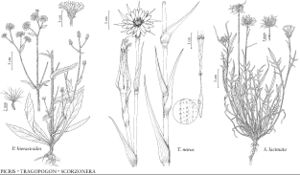Picris
Sp. Pl. 2: 792. 1753.
Gen. Pl. ed. 5, 347. 1754.
| Taxon | Illustrator ⠉ | |
|---|---|---|
 | Picris hieracioides Tragopogon mirus Scorzonera laciniata | Marjorie C. Leggitt Yevonn Wilson-Ramsey Marjorie C. Leggitt |
Annuals, biennials, or perennials, 10–100+ cm; tap or fibrous-rooted, sometimes rhizomatous. Stems usually 1, erect, branched distally, hirsute to hispid or setose (hair tips often 2 [–4] -hooked). Leaves basal and cauline (mostly cauline at flowering); basal ± petiolate, distal sessile; blades oblong, ovate, or lanceolate to oblanceolate or linear, margins entire or sinuate-dentate to pinnately lobed (faces hirsute to hispid or setose, hair tips 2 [–4] -hooked). Heads usually in ± corymbiform arrays. Peduncles not inflated distally, sometimes bracteate. Calyculi of 8–13+, lanceolate to lance-linear bractlets (sometimes ± intergrading with phyllaries). Involucres campanulate to urceolate, 6–12+ mm diam. (sometimes larger in fruit). Phyllaries (8–) 13+ in 1–2 series (reflexed in fruit), lanceolate to lance-linear (± flat or navicular proximally, sometimes each ± enfolding its subtended floret), equal, margins often scarious, apices acute. Receptacles flat to convex, ± pitted, glabrous, epaleate. Florets 30–100+; corollas yellow, often reddish abaxially. Cypselae homomorphic [heteromorphic], reddish-brown [dark-brown], bodies ± fusiform [compressed-ellipsoid], not beaked [beaks ± developed], ribs 5–10, faces transversely rugulose, glabrous; pappi falling, of 30–45+, whitish to stramineous, subequal, barbellulate to plumose bristles [scales] in 2–3+ series (basally connate, falling together). x = 5.
Distribution
Introduced; Europe, Asia, n Africa, also in tropical Africa, Australia
Discussion
Species ca. 40 (2 in the flora).
Selected References
None.
Lower Taxa
Key
| 1 | Annuals; phyllaries navicular proximally, each enfolding its subtended floret; cypselae 2.5– 3 mm | Picris rhagadioloides |
| 1 | Biennials or perennials; phyllaries ± flat proximally, not each enfolding its subtended floret; cypselae 3–4(–6) mm | Picris hieracioides |
"fine" is not a number.